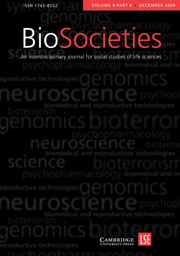Crossref Citations
This article has been cited by the following publications. This list is generated based on data provided by
Crossref.
Kent, Julie
and
ter Meulen, Ruud
2011.
Biobanks and Tissue Research.
Vol. 8,
Issue. ,
p.
17.
Muniesa, Fabian
2011.
A Flank Movement in the Understanding of Valuation.
The Sociological Review,
Vol. 59,
Issue. 2_suppl,
p.
24.
Hoeyer, Klaus
2011.
Anthropologie des objets-frontières humains.
Sociologie et sociétés,
Vol. 42,
Issue. 2,
p.
67.
Lundin, Susanne
2012.
“I Want a Baby; Don't Stop Me from Being a Mother”: An Ethnographic Study on Fertility Tourism and Egg Trade.
Cultural Politics,
Vol. 8,
Issue. 2,
p.
327.
Parry, Bronwyn
2012.
The Wiley‐Blackwell Companion to Economic Geography.
p.
213.
McDonald, Maryon
2012.
A Companion to the Anthropology of Europe.
p.
457.
Martin, Dominique E.
2012.
The Red Market: On the Trail of the World’s Organ Brokers, Bone Thieves, Blood Farmers, and Child Traffickers.
Journal of Bioethical Inquiry,
Vol. 9,
Issue. 2,
p.
205.
Radin, Joanna
2013.
Latent life: Concepts and practices of human tissue preservation in the International Biological Program.
Social Studies of Science,
Vol. 43,
Issue. 4,
p.
484.
Pickersgill, Martyn D.
2013.
From ‘Implications’ to ‘Dimensions’: Science, Medicine and Ethics in Society.
Health Care Analysis,
Vol. 21,
Issue. 1,
p.
31.
Brown, Nik
2013.
Contradictions of value: between use and exchange in cord blood bioeconomy.
Sociology of Health & Illness,
Vol. 35,
Issue. 1,
p.
97.
Hoeyer, Klaus L.
2013.
Commercialization of Tissue-Based Research: Time to Move Beyond the Gift/Market Dichotomy.
Biopreservation and Biobanking,
Vol. 11,
Issue. 6,
p.
397.
Wadmann, Sarah
2014.
Physician–industry collaboration: Conflicts of interest and the imputation of motive.
Social Studies of Science,
Vol. 44,
Issue. 4,
p.
531.
Paul, Katharina T
Avezaat, Cees JJ
Ijzermans, Jan N
Friele, Roland D
and
Bal, Roland A
2014.
Organ donation as transition work: Policy discourse and clinical practice in The Netherlands.
Health: An Interdisciplinary Journal for the Social Study of Health, Illness and Medicine,
Vol. 18,
Issue. 4,
p.
369.
Mohr, Sebastian
2014.
Beyond motivation: on what it means to be a sperm donor in Denmark.
Anthropology & Medicine,
Vol. 21,
Issue. 2,
p.
162.
Busby, Helen
Kent, Julie
and
Farrell, Anne-Maree
2014.
Revaluing donor and recipient bodies in the globalised blood economy: Transitions in public policy on blood safety in the United Kingdom.
Health: An Interdisciplinary Journal for the Social Study of Health, Illness and Medicine,
Vol. 18,
Issue. 1,
p.
79.
Shaw, Rhonda M.
and
Bell, Lara J.M.
2015.
‘Because you can't live on love’: living kidney donors’ perspectives on compensation and payment for organ donation.
Health Expectations,
Vol. 18,
Issue. 6,
p.
3201.
Tyner, James A.
2015.
Population geography II.
Progress in Human Geography,
Vol. 39,
Issue. 3,
p.
360.
Brown, Nik
and
Williams, Rosalind
2015.
Cord blood banking – bio-objects on the borderlands between community and immunity.
Life Sciences, Society and Policy,
Vol. 11,
Issue. 1,
Bugge, Markus
Hansen, Teis
and
Klitkou, Antje
2016.
What Is the Bioeconomy? A Review of the Literature.
Sustainability,
Vol. 8,
Issue. 7,
p.
691.
Winkelmann, Andreas
2016.
Consent and consensus—ethical perspectives on obtaining bodies for anatomical dissection.
Clinical Anatomy,
Vol. 29,
Issue. 1,
p.
70.


